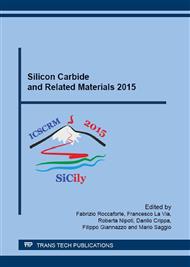[1]
P. Friedrichs. T. Kimoto, L. Ley and G. Pensl (Eds. ), Silicon Carbide, Vol. 1: Growth, Defects, and Novel Applications, WILEY-VCH, Weinheim, (2010).
DOI: 10.1002/9783527629053
Google Scholar
[2]
Y. Hijikata (Ed. ), Physics and Technology of Silicon Carbide Devices, IN-TECH, Rijeka, (2013).
Google Scholar
[3]
B. B. Mandelbrot, The Fractal Geometry of Nature, W.H. Freeman, San Francisco, (1983).
Google Scholar
[4]
D. I. Svergun, Determination of the regularization parameter in indirect-transform methods using perceptual criteria, J. Appl. Cryst. 25 (1992) 495-503.
DOI: 10.1107/s0021889892001663
Google Scholar
[5]
M. V. Logunov, V. A. Neverov, and B. F. Mamin, Investigation of structural inhomogeneity of silicon carbide by the low-angle X-ray scattering method, Applied Physics (Rus) N5 (2014) 15-18.
Google Scholar
[6]
O. H. Seeck, B. Murphy (Eds. ), X-Ray Diffraction: Modern Experimental Techniques, Pan Stanford Publishing Pte. Ltd., Singapore, (2015).
Google Scholar
[7]
T. N. Vasilevskaya, T. V. Antropova, Small-angle X-ray scattering study of the structure of glassy nanoporous matrices, Physics of the Solid State 51 (2009) 2537-2545.
DOI: 10.1134/s1063783409120178
Google Scholar
[8]
T. V. Khamova, O. A. Shilova, G. P. Kopitsa, L. Almásy, L. Rosta, Small-angle neutron scattering study of the mesostructure of bioactive coatings for stone materials based on nanodiamond-modified epoxy siloxane sols, Physics of the Solid State 56 (2014).
DOI: 10.1134/s1063783414010156
Google Scholar
[9]
J. E. Martin, A. J. Hurd, Scattering from fractals, J. Appl. Cryst. 20 (1987) 61 – 78.
Google Scholar


